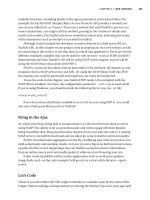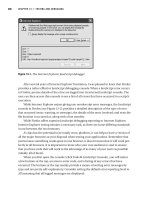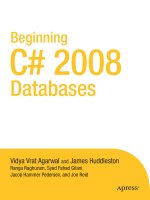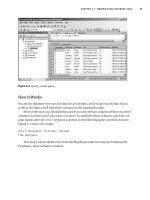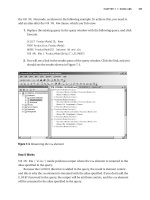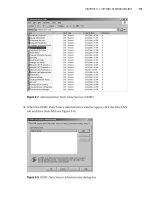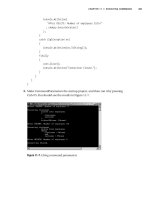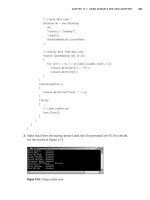Beginning C# 2008 Databases From Novice to Professional phần 6 ppt
Bạn đang xem bản rút gọn của tài liệu. Xem và tải ngay bản đầy đủ của tài liệu tại đây (514.08 KB, 52 trang )
Console.WriteLine(
"After DELETE: Number of employees {0}\n"
, cmdqry.ExecuteScalar()
);
}
catch (SqlException ex)
{
Console.WriteLine(ex.ToString());
}
finally
{
conn.Close();
Console.WriteLine("Connection Closed.");
}
}
}
}
3. Make CommandParameters the startup project, and then run it by pressing
Ctrl+F5. You should see the results in Figure 11-7.
Figure 11-7. U
sing command parameters
CHAPTER 11 ■ EXECUTING COMMANDS 231
9004ch11final.qxd 12/13/07 4:09 PM Page 231
How It Works
First, you set up your sample data.
// set up rudimentary data
string fname = "Zachariah";
string lname = "Zinn";
You then add two parameters, @fname and @lname, to the Parameters collection prop-
erty of the command you want to parameterize.
// create commands
SqlCommand cmdqry = new SqlCommand(sqlqry, conn);
SqlCommand cmdnon = new SqlCommand(sqlins, conn);
Cmdnon.Prepare();
// add parameters to the command for statements
cmdnon.Parameters.Add("@fname", SqlDbType.NVarChar, 10);
cmdnon.Parameters.Add("@lname", SqlDbType.NVarChar, 20);
Note that you provide the parameter names as strings and then specify the data
types of the columns y
ou expect to use them with. The
SqlDbType enumer
ation contains
a member for every SQL Server data type except
cursor and table, which can’t be directly
used by C# programs. The
Add method is overloaded. Since nvarchar requires you to spec-
ify its maximum length, you include that as the third argument.
Finally, you set the parameter values before executing the command.
// execute nonquery to insert an employee
cmdnon.Parameters["@fname"].Value = fname;
cmdnon.Parameters["@lname"].Value = lname;
■Note You use the same command, cmdnon, to execute both the INSERT and DELETE statements. The
parameter values don’t change, even though the SQL in
CommandText does. The Parameters collection is
the source of parameter values for wha
tever SQL is in
CommandText.
The SQL does not ha
ve to use all or
even any of the parameters, but it cannot use any parameters not in the command’s Parameters collection.
Notice in Figure 11-7 that when you display the SQL in CommandText, you see the
parameter names rather than their values. Values are substituted for parameters when
CHAPTER 11 ■ EXECUTING COMMANDS232
9004ch11final.qxd 12/13/07 4:09 PM Page 232
the SQL is submitted to the database server, not when the values are assigned to the
members of the
Parameters collection.
Summary
In this chapter, we covered what an ADO.NET command is and how to create a command
object. We also discussed associating a command with a connection, setting command
text, and using
ExecuteScalar(), ExecuteReader(), and ExecuteNonQuery() statements.
In the next chapter, you’ll look at data readers.
CHAPTER 11 ■ EXECUTING COMMANDS 233
9004ch11final.qxd 12/13/07 4:09 PM Page 233
9004ch11final.qxd 12/13/07 4:09 PM Page 234
Using Data Readers
In Chapter 11, you used data readers to retrieve data from a multirow result set. In this
chapter, we’ll look at data readers in more detail. You’ll see how they’re used and their
importance in ADO.NET programming.
In this chapter, we’ll cover the following:
• Understanding data readers in general
• Getting data about data
• Getting data about tables
• Using multiple result sets with a data reader
Understanding Data Readers in General
The third component of a data provider, in addition to connections and commands, is
the
data reader. Once y
ou’ve connected to a database and queried it, you need some way
to access the result set. This is where the data reader comes in.
■Note If you’re from an ADO background, an ADO.NET data reader is like an ADO forward-only/read-only
client-side recordset, but it’s not a COM object.
Data readers are objects that implement the System.Data.IDataReader interface. A
data reader is a fast, unbuffered, forward-only, read-only
connected stream that retrieves
data on a per-row basis. It reads one row at a time as it loops through a result set.
235
CHAPTER 12
9004ch12final.qxd 12/13/07 4:07 PM Page 235
You can’t directly instantiate a data reader; instead, you create one with the
ExecuteReader method of a command. For example, assuming cmd is a SqlClient
command object for a query, here’s how to create a SqlClient data reader:
SqlDataReader rdr = cmd.ExecuteReader();
You can now use this data reader to access the query’s result set.
■Tip One point that we’ll discuss further in the next chapter is choosing a data reader vs. a dataset. The
general rule is to always use a data reader for simply retrieving data. If all you need to do is display data, all
you need to use in most cases is a data reader.
We’ll demonstrate basic data reader usage with a few examples. The first example is
the most basic; it simply uses a data reader to loop thr
ough a result set.
Let’s say you’ve successfully established a connection with the database, a query has
been executed, and everything seems to be going fine—what now? The next sensible
thing to do would be to retrieve the rows and process them.
Try It Out: Looping Through a Result Set
The following console application shows how to use a SqlDataReader to loop through
a result set and retrieve rows.
1. Create a new Console Application project named Chapter12. When Solution
Explorer opens, save the solution.
2. Rename the Chapter12 project to DataLooper. Rename the Program.cs file to
DataLooper.cs, and replace the generated code with the code in Listing 12-1.
Listing 12-1. DataLooper.cs
using System;
using System.Data;
using System.Data.SqlClient;
CHAPTER 12 ■ USING DATA READERS236
9004ch12final.qxd 12/13/07 4:07 PM Page 236
namespace Chapter12
{
class DataLooper
{
static void Main(string[] args)
{
// connection string
string connString = @"
server = .\sqlexpress;
integrated security = true;
database = northwind
";
// query
string sql = @"
select
contactname
from
customers
";
// create connection
SqlConnection conn = new SqlConnection(connString);
try
{
// open connection
conn.Open();
// create command
SqlCommand cmd = new SqlCommand(sql, conn);
// create data reader
SqlDataReader rdr = cmd.ExecuteReader();
// loop through result set
while (rdr.Read())
{
// print one row at a time
Console.WriteLine("{0}", rdr[0]);
}
CHAPTER 12 ■ USING DATA READERS 237
9004ch12final.qxd 12/13/07 4:07 PM Page 237
// close data reader
rdr.Close();
}
catch(Exception e)
{
Console.WriteLine("Error Occurred: " + e);
}
finally
{
//close connection
conn.Close();
}
}
}
}
3. Run the DataLooper by pressing Ctrl+F5. You should see the results in Figure 12-1.
Figure 12-1. Looping through a result set
How It Works
SqlDataReader is an abstr
act class and can’t be instantiated explicitly. For this reason,
y
ou obtain an instance of a
SqlDataReader b
y executing the
ExecuteReader method
of
SqlCommand.
// create data reader
SqlDataReader rdr = cmd.ExecuteReader();
ExecuteReader()
doesn’t just create a data reader, it sends the SQL to the connection
for execution, so when it returns you can loop through each row of the result set and
CHAPTER 12 ■ USING DATA READERS238
9004ch12final.qxd 12/13/07 4:07 PM Page 238
retrieve values column by column. To do this, you call the Read method of SqlDataReader,
which returns
true if a row is available and advances the cursor (the internal pointer to
the next row in the result set) or returns
false if another row isn’t available. Since Read()
advances the cursor to the next available row, you have to call it for all the rows in the
result set, so you call it as the condition in a
while loop:
// loop through result set
while (rdr.Read())
{
// print one row at a time
Console.WriteLine("{0}", rdr[0]);
}
Once you call the Read method, the next row is returned as a collection and stored in
the
SqlDataReader object itself. To access data from a specific column, you can use a num-
ber of methods (we’ll cover these in the next section), but for this application you use the
ordinal indexer lookup method, giving the column number to the reader to retrieve val-
ues (just as you’d specify an index for an array). Since in this case you choose a single
column from the Customers table while querying the database, only the “zeroth” indexer
is accessible, so you hard-code the index as
rdr[0].
To use the
connection for another purpose or to run another query on the database,
it’s important to call the
Close method of SqlDataReader to close the reader explicitly.
Once a reader is attached to an active connection, the connection remains busy fetch-
ing data for the reader and remains unavailable for other use until the reader has been
detached from it. That’s why you close the reader in the
try block rather than in the
finally block (even though this simple program doesn’t need to use the connection for
another purpose).
// close data reader
rdr.Close();
Using Ordinal Indexers
Y
ou use
an or
dinal indexer to r
etrieve column data from the result set. Let’s learn more
about or
dinal indexers
.
The code
rdr[0]
is a reference to the data reader’s Item property and returns the value in the column spec-
ified for the curr
ent r
o
w
.
The v
alue is r
etur
ned as an object.
CHAPTER 12 ■ USING DATA READERS 239
9004ch12final.qxd 12/13/07 4:07 PM Page 239
Try It Out: Using Ordinal Indexers
In this example, you’ll build a console application that uses an ordinal indexer.
1. Add a new C# Console Application project named OrdinalIndexer to your
Chapter12 solution. Rename
Program.cs to OrdinalIndexer.cs.
2. Replace the code in OrdinalIndexer.cs with the code in Listing 12-2.
Listing 12-2. OrdinalIndexer.cs
using System;
using System.Data;
using System.Data.SqlClient;
namespace Chapter07
{
class OrdinalIndexer
{
static void Main(string[] args)
{
// connection string
string connString = @"
server = .\sqlexpress;
integrated security = true;
database = northwind
";
// query
string sql = @"
select
companyname,
contactname
from
customers
where
contactname like 'M%'
";
// create connection
SqlConnection conn = new SqlConnection(connString);
CHAPTER 12 ■ USING DATA READERS240
9004ch12final.qxd 12/13/07 4:07 PM Page 240
try
{
// open connection
conn.Open();
// create command
SqlCommand cmd = new SqlCommand(sql, conn);
// create data reader
SqlDataReader rdr = cmd.ExecuteReader();
// print headings
Console.WriteLine("\t{0} {1}",
"Company Name".PadRight(25),
"Contact Name".PadRight(20));
Console.WriteLine("\t{0} {1}",
"============".PadRight(25),
"============".PadRight(20));
// loop through result set
while (rdr.Read())
{
Console.WriteLine(" {0} | {1}",
rdr[0].ToString().PadLeft(25),
rdr[1].ToString().PadLeft(20));
}
// close reader
rdr.Close();
}
catch(Exception e)
{
Console.WriteLine("Error Occurred: " + e);
}
finally
{
// close connection
conn.Close();
}
}
}
}
CHAPTER 12 ■ USING DATA READERS 241
9004ch12final.qxd 12/13/07 4:07 PM Page 241
3. Make OrdinalIndexer the startup project, and run it by pressing Ctrl+F5. You
should see the results in Figure 12-2.
Figure 12-2. Displaying multiple columns
How It Works
You quer
y the Customers table for the columns CompanyName and ContactName,
where contact names begin with the letter “M.”
// query
string sql = @"
select
companyname,
contactname
from
customers
where
contactname like 'M%'
";
Since two columns are selected by your query, the returned data also comprises a
collection of rows from only these two columns, thus allowing access to only two possible
ordinal indexers, 0 and 1.
You read each row in a
while loop, fetching values of the two columns with their
indexers. Since the returned value is an object, you need to explicitly convert the value to
a string so that you can use the
PadLeft method to format the output in such a way that
all the characters will be right-aligned, being padded with spaces on the left for a speci-
fied total length.
CHAPTER 12 ■ USING DATA READERS242
9004ch12final.qxd 12/13/07 4:07 PM Page 242
// loop through result set
while (rdr.Read())
{
Console.WriteLine(" {0} | {1}",
rdr[0].ToString().PadLeft(25),
rdr[1].ToString().PadLeft(20));
}
After processing all rows in the result set, you explicitly close the reader to free the
connection.
// close reader
rdr.Close();
Using Column Name Indexers
Most of the time we don’t really keep track of column numbers and prefer retrieving
values by their respective column names, simply because it’s much easier to remember
them by their names, which also makes the code more self-documenting.
You use column name indexing by specifying column names instead of ordinal
index numbers. This has its advantages. For example, a table may be changed by the
addition or deletion of one or more columns, upsetting column ordering and raising
exceptions in older code that uses ordinal indexers. Using column name indexers
would avoid this issue, but ordinal indexers are faster, since they directly reference
columns rather than look them up by name.
The following code snippet retrieves the same columns (CompanyName and
ContactName) that the last example did, using column name indexers.
// loop through result set
while (rdr.Read())
{
Console.WriteLine(" {0} | {1}",
rdr["companyname"].ToString().PadLeft(25),
rdr["contactname"].ToString().PadLeft(20));
}
R
eplace the ordinal indexers in
OrdinalIndexer.cs with column name indexers
, rerun
the pr
oject, and you’ll get the same results as in Figure 12-2.
The next section discusses a better approach for most cases.
CHAPTER 12 ■ USING DATA READERS 243
9004ch12final.qxd 12/13/07 4:07 PM Page 243
Using Typed Accessor Methods
When a data reader returns a value from a data source, the resulting value is retrieved
and stored locally in a .NET type rather than the original data source type. This in-place
type conversion feature is a trade-off between consistency and speed, so to give some
control over the data being retrieved, the data reader exposes typed accessor methods
that you can use if you know the specific type of the value being returned.
Typed accessor methods all begin with
Get, take an ordinal index for data retrieval,
and are type safe; C# won’t allow you to get away with unsafe casts. These methods turn
out to be faster than both the ordinal and the column name indexer methods. Being
faster than column name indexing seems only logical, as the typed accessor methods
take ordinals for referencing; however, we need to explain how it’s faster than ordinal
indexing. This is because even though both techniques take in a column number, the
conventional ordinal indexing method needs to look up the data source data type of the
result and then go through a type conversion. This overhead of looking up the schema is
avoided with typed accessors.
.NET types and typed accessor methods are available for almost all data types sup-
ported by SQL Server and OLE DB databases.
Table 12-1 should give you a brief idea of when to use typed accessors and with what
data type. It lists SQL Server data types, their corresponding .NET types, .NET typed
accessors, and special SQL Server–specific typed accessors designed particularly for
returning objects of type
System.Data.SqlTypes.
Table 12-1. SQL Server Typed Accessors
SQL Server Data Types .NET Type .NET Typed Accessor
bigint Int64 GetInt64
binary Byte[] GetBytes
bit Boolean GetBoolean
char String
or Char[] GetString or GetChars
datetime DateTime GetDateTime
decimal Decimal GetDecimal
float Double GetDouble
image
or long varbinary
Byte[] GetBytes
int
Int32
GetInt32
money Decimal GetDecimal
nchar String
or Char[] GetString or GetChars
ntext String or Char[] GetString or GetChars
numeric Decimal GetDecimal
CHAPTER 12 ■ USING DATA READERS244
9004ch12final.qxd 12/13/07 4:07 PM Page 244
SQL Server Data Types .NET Type .NET Typed Accessor
nvarchar String or Char[] GetString or GetChars
real Single GetFloat
smalldatetime DateTime GetDateTime
smallint Int16 GetInt16
smallmoney Decimal GetDecimal
sql_variant Object GetValue
long varchar String or Char[] GetString or GetChars
timestamp Byte[] GetBytes
tinyint Byte GetByte
uniqueidentifier Guid GetGuid
varbinary
Byte[]
GetBytes
varchar String or Char[] GetString or GetChars
Here are some available OLE DB data types, their corresponding .NET types, and
their .NET typed accessors (see Table 12-2).
Table 12-2. OLE DB Typed Accessors
OLE DB Type .NET Type .NET Typed Accessor
DBTYPE_I8 Int64 GetInt64
DBTYPE_BYTES Byte[] GetBytes
DBTYPE_BOOL Boolean
GetBoolean
DBTYPE_BSTR String GetString
DBTYPE_STR
String
GetString
DBTYPE_CY Decimal GetDecimal
DBTYPE_DATE DateTime GetDateTime
DBTYPE_DBDATE
DateTime
GetDateTime
DBTYPE_DBTIME DateTime GetDateTime
DBTYPE_DBTIMESTAMP DateTime GetDateTime
DBTYPE_DECIMAL Decimal GetDecimal
DBTYPE_R8 Double GetDouble
DBTYPE_ERROR
ExternalException
GetValue
Continued
CHAPTER 12 ■ USING DATA READERS 245
9004ch12final.qxd 12/13/07 4:07 PM Page 245
Table 12-2. Continued
OLE DB Type .NET Type .NET Typed Accessor
DBTYPE_FILETIME DateTime GetDateTime
DBTYPE_GUID Guid GetGuid
DBTYPE_I4 Int32 GetInt32
DBTYPE_LONGVARCHAR String GetString
DBTYPE_NUMERIC Decimal GetDecimal
DBTYPE_R4 Single GetFloat
DBTYPE_I2 Int16 GetInt16
DBTYPE_I1 Byte GetByte
DBTYPE_UI8 UInt64 GetValue
DBTYPE_UI4 UInt32 GetValue
DBTYPE_UI2 UInt16 GetValue
DBTYPE_VARCHAR String GetString
DBTYPE_VARIANT Object GetValue
DBTYPE_WVARCHAR String GetString
DBTYPE_WSRT String GetString
To see typed accessors in action, you’ll build a console application that uses them.
For this example, you’ll use the Products table from the Northwind database.
Table 12-3 shows the data design of the table. Note that the data types given in the
table will be looked up for their corresponding typed accessor methods in Table 12-1 so
you can use them correctly in your application.
T
able 12-3.
N
or
thwind P
roducts Table Data Types
Column Name
Data T
ype
Length
Allow Nulls?
ProductID (unique) int 4No
ProductName nvarchar 40 No
SupplierID
int
4
Yes
CategoryID int 4Yes
QuantityPerUnit nvarchar 20 Yes
UnitPrice
money
8
Y
es
CHAPTER 12 ■ USING DATA READERS246
9004ch12final.qxd 12/13/07 4:07 PM Page 246
Column Name Data Type Length Allow Nulls?
UnitsInStock smallint 2Yes
UnitsOnOrder smallint 2Yes
ReorderLevel smallint 2Yes
Discontinued bit 1No
Try It Out: Using Typed Accessor Methods
Here, you’ll build a console application that uses typed accessors.
1. Add a new C# Console Application project named TypedAccessors to your
Chapter12 solution. Rename
Program.cs to TypedAccessors.cs.
2. Replace the code in TypedAccessors.cs with the code in Listing 12-3.
Listing 12-3. TypedAccessors.cs
using System;
using System.Data;
using System.Data.SqlClient;
namespace Chapter12
{
class TypedAccessors
{
static void Main(string[] args)
{
// connection string
string connString = @"
server = .\sqlexpress;
integrated security = true;
database = northwind
";
CHAPTER 12 ■ USING DATA READERS 247
9004ch12final.qxd 12/13/07 4:07 PM Page 247
// query
string sql = @"
select
productname,
unitprice,
unitsinstock,
discontinued
from
products
";
// create connection
SqlConnection conn = new SqlConnection(connString);
try
{
// open connection
conn.Open();
// create command
SqlCommand cmd = new SqlCommand(sql, conn);
// create data reader
SqlDataReader rdr = cmd.ExecuteReader();
// fetch data
while (rdr.Read())
{
Console.WriteLine(
"{0}\t {1}\t\t {2}\t {3}",
// nvarchar
rdr.GetString(0).PadRight(30),
// money
rdr.GetDecimal(1),
// smallint
rdr.GetInt16(2),
// bit
rdr.GetBoolean(3));
}
CHAPTER 12 ■ USING DATA READERS248
9004ch12final.qxd 12/13/07 4:07 PM Page 248
// close data reader
rdr.Close();
}
catch(Exception e)
{
Console.WriteLine("Error Occurred: " + e);
}
finally
{
// close connection
conn.Close();
}
}
}
}
3. Make TypedAccessors the startup project, and run it by pressing Ctrl+F5. You
should see the results in Figure 12-3. (Only the first 20 rows are displayed in the
figure.)
Figure 12-3. Using typed accessors
How It Works
You query the Products table for ProductName, UnitPrice, UnitsInStock, and
Discontinued.
CHAPTER 12 ■ USING DATA READERS 249
9004ch12final.qxd 12/13/07 4:07 PM Page 249
// query
string sql = @"
select
productname,
unitprice,
unitsinstock,
discontinued
from
products
";
The reason we have you choose these columns is to deal with different kinds of data
types and show how to use relevant typed accessors to obtain the correct results.
// fetch data
while (rdr.Read())
{
Console.WriteLine(
"{0}\t {1}\t\t {2}\t {3}",
// nvarchar
rdr.GetString(0).PadRight(30),
// money
rdr.GetDecimal(1),
// smallint
rdr.GetInt16(2),
// bit
rdr.GetBoolean(3));
}
Looking at Table 12-1, you can see that you can access nvarchar, money, smallint, and
bit data types
in SQL Server with the
GetString, GetDecimal, GetInt16, and GetBoolean
accessor methods
, respectively.
This technique is fast and completely type safe
. B
y this
, w
e mean that if implicit con-
v
ersions fr
om nativ
e data types to .NET types fail, an ex
ception is thrown for invalid
casts
. F
or instance
, if y
ou try using the
GetString method on a bit data type instead of
using the
GetBoolean method, a
“
S
pecified cast is not valid” exception will be thrown.
CHAPTER 12 ■ USING DATA READERS250
9004ch12final.qxd 12/13/07 4:07 PM Page 250
Getting Data About Data
So far, all you’ve done is retrieve data from a data source. Once you have a populated data
reader in your hands, you can do a lot more. Here are a number of useful methods for
retrieving schema information or retrieving information directly related to a result set.
Table 12-4 describes some of the metadata methods and properties of a data reader.
Table 12-4. Data Reader Metadata Properties and Methods
Method or Property Name Description
Depth A property that gets the depth of nesting for the current row
FieldCount A property that holds the number of columns in the current row
GetDataTypeName A method that accepts an index and returns a string containing the
name of the column data type
GetFieldType A method that accepts an index and returns the .NET Framework
type of the object
GetName A method that accepts an index and r
eturns the name of the
specified column
GetOrdinal A method that accepts a column name and returns the column
index
GetSchemaTable A method that returns column metadata
HasRows A property that indicates whether the data reader has any rows
RecordsAffected A property that gets the number of rows changed, inserted, or
deleted
Try It Out: Getting Information About a Result Set with a
Data Reader
I
n this exer
cise
, y
ou’ll use some of these methods and properties.
1. A
dd a new C# Console Application project named ResultSetInfo to your Chapter12
solution. R
ename
Program.cs to ResultSetInfo.cs.
2. Replace the code in ResultSetInfo.cs with the code in Listing 12-4.
CHAPTER 12 ■ USING DATA READERS 251
9004ch12final.qxd 12/13/07 4:07 PM Page 251
Listing 12-4. ResultSetInfo.cs
u
sing System;
u
sing System.Data;
u
sing System.Data.SqlClient;
namespace Chapter12
{
class ResultSetInfo
{
static void Main(string[] args)
{
// connection string
string connString = @"
server = .\sqlexpress;
integrated security = true;
database = northwind
";
// query
string sql = @"
select
contactname,
contacttitle
from
customers
where
contactname like 'M%'
";
// create connection
SqlConnection conn = new SqlConnection(connString);
try
{
conn.Open();
SqlCommand cmd = new SqlCommand(sql, conn);
SqlDataReader rdr = cmd.ExecuteReader();
CHAPTER 12 ■ USING DATA READERS252
9004ch12final.qxd 12/13/07 4:07 PM Page 252
// get column names
Console.WriteLine(
"Column Name:\t{0} {1}",
rdr.GetName(0).PadRight(25),
rdr.GetName(1));
// get column data types
Console.WriteLine(
"Data Type:\t{0} {1}",
rdr.GetDataTypeName(0).PadRight(25),
rdr.GetDataTypeName(1));
Console.WriteLine();
while (rdr.Read())
{
// get column values for all rows
Console.WriteLine(
"\t\t{0} {1}",
rdr.GetString(0).ToString().PadRight(25),
rdr.GetString(1));
}
// get number of columns
Console.WriteLine();
Console.WriteLine(
"Number of columns in a row: {0}",
rdr.FieldCount);
// get info about each column
Console.WriteLine(
"'{0}' is at index {1} " +
"and its type is: {2}",
rdr.GetName(0),
rdr.GetOrdinal("contactname"),
rdr.GetFieldType(0));
CHAPTER 12 ■ USING DATA READERS 253
9004ch12final.qxd 12/13/07 4:07 PM Page 253
Console.WriteLine(
"'{0}' is at index {1} " +
"and its type is: {2}",
rdr.GetName(1),
rdr.GetOrdinal("contacttitle"),
rdr.GetFieldType(1));
rdr.Close();
}
catch(Exception e)
{
Console.WriteLine("Error Occurred: " + e);
}
finally
{
conn.Close();
}
}
}
}
3. Make R
esultSetInfo the startup project, and run it by pressing Ctrl+F5. You should
see the results in Figure 12-4.
Figure 12-4. Displaying result set metadata
CHAPTER 12 ■ USING DATA READERS254
9004ch12final.qxd 12/13/07 4:07 PM Page 254
How It Works
The GetName method gets a column name by its index. This method returns information
about the result set, so it can be called before the first call to Read().
// get column names
Console.WriteLine(
"Column Name:\t{0} {1}",
rdr.GetName(0).PadRight(25),
rdr.GetName(1));
The GetDataTypeName method returns the database data type of a column. It too can
be called before the first call to
Read().
// get column data types
Console.WriteLine(
"Data Type:\t{0} {1}",
rdr.GetDataTypeName(0).PadRight(25),
rdr.GetDataTypeName(1));
The FieldCount property of the data reader contains the number of columns in the
result set. This is useful for looping through columns without knowing their names or
other attributes.
// get number of columns
Console.WriteLine();
Console.WriteLine(
"Number of columns in a row: {0}",
rdr.FieldCount);
Finally, you see how the GetOrdinal and GetFieldType methods are used. The former
returns a column index based on its name; the latter returns the C# type. These are the
countertypes of
GetName() and GetDataTypeName(), respectively.
// get info about each column
Console.WriteLine(
"'{0}' is at index {1} " +
"and its type is: {2}",
rdr.GetName(0),
rdr.GetOrdinal("contactname"),
rdr.GetFieldType(0));
So much for obtaining information about result sets. You’ll now learn how to get
information about schemas.
CHAPTER 12 ■ USING DATA READERS 255
9004ch12final.qxd 12/13/07 4:07 PM Page 255

